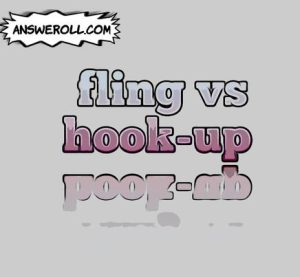The world of dating and relationships is a vast one. Coupled with the modernization of a lot of things, new terms have emerged which represent different forms of intimate partnership between a person and their perceived significant other.
Fling and Linking up are one such term that now draws the line between casual affairs and the traditional form of intimate association.
But there have been cases where one term is mistaken for the other and this often leads to misunderstanding.
In most scenarios, one party feels used and hurt. Hence there is a need to draw the line between these two terms and also exposit on their similarities.
Let’s get into the meat of this subject as I provide you with details concerning the comparison between fling and Linking up.
Major Difference between Fling and Hookup

The chief disparity that exists between a fling and Linking up is the time frame in which this partnership or liaison lasts for.
The Hollywood Madam Heidi Fleiss propounded that a fling lasts between 2 days to nine months. And from calculations, anything shorter than this is a one-night stand or Linking up so to say, while anything longer is a long-term relationship.
To this end, a fling lasts longer than a Linking up and that is exactly the major difference between the two of them. Another difference that exists between the two terms is the involvement of genital intercourse.
While genital intercourse is a prerequisite for a Linking up relationship t flourish, it is not necessarily needed in a fling but can still happen as the time frame elongates.
Hence, the involvement or rather non-involvement of genital intercourse is another plausible similarity that counts between a fling and Linking up.
The chance of any of these liaisons leading to a serious relationship is another difference between them.
A fling has the potential of leading to something serious and committal because of its long involvement. In contrast, a Linking up has little possibility of ever becoming a serious relationship.
What Does a Fling Mean?

A fling is a short-lived “situationship” between two compatible individuals, with no strings attached. This implies that the partnership is done in a way where it frowns at the development of feelings.
Hence, there is no intention whatsoever to nurture any form of feeling for the person who you are in a fling with.
The pact is another feature of a fling that the parties involved agree on. This form of mutual agreement signals the start of the relationship, and all the rules of engagement are discussed.
Also, there is no initial intention the relationship will graduate into something serious, but it could do so with time.
Sadly, there have been situations where only one partner in the relationship sees it as a fling while the other counts it as a serious entanglement.
In this instance, the person who feels more in the relationship may get hurt. I can tell you about this subject because I had quite a similar experience.
I was once caught up in a relationship and it was like a fling for me because my partner didn’t have it takes to show her to my parents. But I felt she wanted more than just genital intercourse which was just fine by me.
To avoid further connections, I had to call it off before it became too deep. That there, was a very clear example of a fling because we were hooked up for over 6 months. Both single and married individuals can take part in a fling.
What Does Hookup Mean?

A Linking up is a non-committal one-time instance liaison with a person involving genital intercourse. A Linking up could go on after the one-time hit but it is a casual relationship built intentionally.
There are too many terms in this definition so I’ll simplify them. The first one is non-committal which means there is no form of emotional connection or chemistry in the relationship.
It further means that none of the individuals involved is expected to cultivate emotional attachment to the other person.
The other term is the liaison which simply means the relationship itself. The only difference between a Linking up and the traditional dating format is the involvement of casual intercourse.
It also differs from other new generational dating terms like fling because it has a shorter time frame, while it shares some similarities with a one-night stand.
If the relationship is not mutual, people also pay for a Linking up. In this case, whether it is a straight or same-sex setup, the feminine counterpart receives the payment.
Notably, Linking ups mostly involve married individuals more than singles because it is more short-lived than a fling or relationship and slightly longer than a one-night stand.
What Similarities Do They Share?
The differences between a fling and a Linking up also come with a couple of similarities. Some of these similarities include.
- They are both non-committal
- Both of them usually involve two individuals
- There is an involvement of genital intercourse
- There is usually a mutual agreement
- It can be done by both singles and married individuals
They Are Both Non-committal
This similarity between these two terms of engagement stands out. It is one factor that governs these two terms because there’s no involvement of feelings.
There is an absence of any form of emotional chemistry or connection and this is usually stated at the inception of any of these liaisons.
But there have been cases where one party starts to develop emotional attachment which often leads to disappointment in the long run.
Both of Them Usually Involves Two Individuals
Both a fling and Linking up mostly involve two individuals. I’ve not heard of any case where there are more than just two persons in such a setting.
The only exception is in the case of a mutually participated threesome. Aside from that, only two persons are involved in either a fling or Linking up.
There Is an Involvement of Intercourse
Getting under the sheets is another similarity that exists between a fling and a Linking up. It is almost unheard of; to see a fling or Linking up relationship that doesn’t involve intercourse.
In most cases, the relationship is given a tag after intercourse. While in others, intercourse comes along in the course of the relationship.
There Is Usually a Mutual Agreement
A mutual pact is one factor that makes a fling and Linking up similar to each other. All the rules of engagement and the forms of the meeting are discussed in the agreement. The agreement is to favor both parties involved in the relationship.
It Can Be Done by Both Singles and Married Individuals
Both a fling and Linking up relationship is not restricted to only singles, as married individuals can also participate in it.
According to the claims of the Madam-to-the-stars Heidi Fleiss, most of the men who patronized her call-girl services were mostly married men.
These services also included both flings and Linking ups, as most of her girls were captured in private jets to Paris and other exclusive locations.
Why It Is Important To Separate Them
It is important to separate a fling and Linking up, because of the implications that can arise if it is not done. Some of these implications include.
- To avoid expectancy and disappointment
- To steer clear of exploitation
- To help you understand which one you’re into
To Avoid Expectancy and Disappointment
It is pertinent that we separate these two terms because of the issue of expectancy and disappointment.
This is to avoid cases where one party feels exploited or used by the other. In a Linking up, if a partner expects more time it implies a fling.
If the other partner does not reciprocate the interest, it could lead to disappointment. Hence, separating a fling from a Linking up at the point of the mutual agreement becomes an important factor.
To Steer Clear of Exploitation
Just like the prior reason, avoiding a case of exploitation is important in differentiating between a fling and a Linking up. With this type of discretion in place, you can curtail the issue of exploitation.
To Help You Understand Which One You’re Into
Differentiating between a fling and a Linking up will also help you understand which side you are on. This way, you’ll know when you’re swaying from a Linking up to a fling, and equally when a fling is graduating into a full-stack relationship.
If you need a single formula for reading the evolution of these liaisons, then you have to watch your partner’s body language and also look at the relationship’s time frame.
Conclusion
This is the point where I draw the curtain on this post which exposits on the comparison between a fling and Linking up.
I’m convinced that you got value in the course of this article which started with the major differences between the two terms, down to the definition and then the similarities.
I also explained the need why these two terms should be separated from each other, to avoid certain pitfalls. However, you can drop comments on your idea about this post, and do not forget to hit the share icon.
